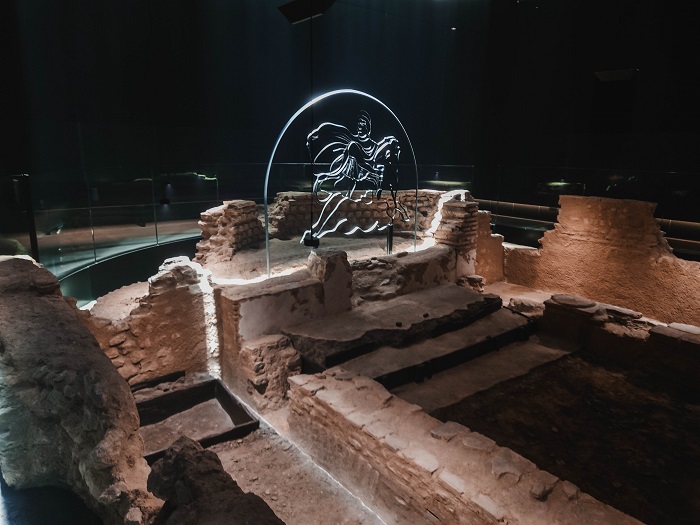During the time of the Romans, Londinium was the center of military power and cultural life in the British province. Nestled along the northern shore of the River Thames, roughly occupying approximately half of the current site of the City of London, the city was a road nexus and major port, remaining so throughout Rome’s occupation of Britain.
Much archaeology has been done exposing the city’s Roman past. From various excavations we have learned much about the city’s religious life. We know that the old Celtic religion survived, after a fashion. The importance of water sources such as springs remain in the archaeological record.
In the streambed of the now-vanished River Walbrook, a small square hammered lead sheet was found, on which an enemy of someone named Martia Martina had inscribed her name backwards and thrown the token into the stream, the traditional Celtic way of reaching the gods.
We know that the Roman pantheon was also honored, due to a dedication to Mars being found in a Romano-British temple at Empire Square, Long Lane, Southwark. Construction in the city after the destruction of the Second World War discovered a mysterious temple, to a cult that has since long disappeared.
Along the east bank of the Walbrook once existed a temple to Mithras, called a Mithraeum. The identification was made based on the discovery of a marble relief, of Mithras in the act of killing the astral bull, the Tauroctony – symbology as powerful to Mithraism as the Crucifixion is to Christianity. In the scene, Mithras is accompanied by two small figures in Phrygian caps – Cautes and Cautopates.
The celestial twins bear torches representing Light and Darkness, standing within the cosmic annual wheel of the zodiac. Outside of the circle, top left – Sol Invictus, the Unconquerable Sun, ascends the heavens in his chariot while Luna, the goddess of the moon, descends in her chariot. The relief bears the inscription:
"VLPIVS SILVANVS EMERITVS LEG II AVG VOTVM SOLVIT FACTVS ARAVSIONE"
Which translates to “Ulpius Silvanus, veteran soldier of the Legio II Augusta, in fulfilment of a vow, makes this altar.”
Mithras was originally a deity from the East, indicative of Indo-Iranian religion. Likely due to Rome’s campaigns against the Parthians and Sassanids, the deity became very popular among the legions, who disseminated its worship throughout the Roman Empire. The Legio II Augusta, which assisted with the building of Hadrian’s Wall and the Antonine Wall, appears to have been responsible for the construction of the London Mithraeum during the mid-3rd century AD.
The temple was constructed partly underground, recalling the cave of Mithras where the Tauroctony was believed to have taken place. Having been moved during the 1960s to location on Queen Victoria Street, it can now be found in its original location, 23 feet underground. There is a singular vestibule, which stands across from an apse at the back of which stands an altar on a pedestal. The “cave”, called the spelaeum or spelunca, has raised benches along the side walls for the ritual meal. Much of the material used in the reconstruction is original, and the temple’s museum even holds an initiation ceremony every 20 minutes for visitors.
The temple is a fascinating descent into the lost sacred world of imperial Rome, where many cults, deities, and traditions once vied for supremacy, before the overall victory of Christianity.

